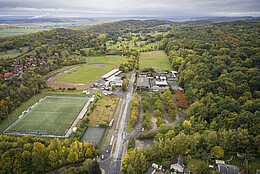Salzgitter-Bad
In September 1944, the SS and the industrial conglomerate known as the “Reichswerke Hermann Göring” established a satellite camp of Neuengamme concentration camp in Salzgitter-Bad. Female concentration camp prisoners were forced to produce ammunition in the “AG für Bergbau- und Hüttenbedarf”, a mining and steel works subsidiary of the “Reichswerke Hermann Göring”, and in the “Kleineisenwerk Salzgitter”, an ironworks subcontractor.
Around 500 women were housed in four huts in the former “Civilian Labourers’ Camp No. 43” of the “AG für Bergbau- und Hüttenbedarf” which was located on the southern edge of the town. These prisoners had been taken to Salzgitter from the Ravensbrück and Bergen-Belsen concentration camps, and they included many Polish women who had been arrested during the Warsaw Uprising.
To reach the “AG für Bergbau und Hüttenbedarf”, the women had to walk around three kilometres through the city, watched by female guards and SS men. The women who worked in the ironworks were taken there through the town on lorries. Working in three shifts, the women produced artillery shells and munitions accessories.
Although the living conditions were extremely bad in the Salzgitter-Bad satellite camp, only four prisoner deaths are recorded in the cemetery index. These four prisoners were buried in the Jammertal cemetery in Salzgitter. The women who were “unable to work” were taken back to Ravensbrück concentration camp or transferred to other satellite camps.
The SS evacuated the camp on 7 April 1945. The women were taken first to the Drütte satellite camp, from where they were transported by train to Celle along with the male prisoners from the Drütte camp. The train carrying about 3,420 prisoners was hit by American bombs at the goods station in Celle on the night of 8 April 1945. Several hundred prisoners died from the resulting explosion of a nearby munitions train and because they were not allowed to leave the train cars in which they had been locked. Those who were able to escape from the train were hunted down by the SS, the police, the Wehrmacht, the Volkssturm, the local Hitler Youth and some residents of Celle. 200 to 300 prisoners were shot or killed. At noon on 9 April, most of those who survived the bomb attack were forced to start marching to Bergen-Belsen. 300 injured prisoners who were “unable to march” were largely left to their own devices in the huts of the "Heidekaserne” barracks in Celle, where the survivors were liberated by British troops on 12 April.
It is not known how many women from Salzgitter-Bad survived the end of the war.
At the end of 1944, the camp commander was SS-Untersturmführer Longin Bladowski.
Period
19 September 1944 to 7 April 1945
Number of Prisoners
500 Female Prisoners
Kind of Work
Artillery shell production
Labor on Behalf of
AG für Bergbau- und Hüttenbedarf of the Reichswerke Hermann Göring
Location
Directions
Salzgitter-Bad
Friedrich-Ebert-Straße
38259 Salzgitter
Germany
Directions by public transportation: From the Salzgitter-Bad railway station, take bus 612 to the final stop, “Kolpingstraße”.
Memorial
On 10 April 1995, a memorial stone commemorating the satellite camp was dedicated at the initiative of the “Arbeitskreis Stadtgeschichte”, a local history organisation. The stone was funded by private donations and the city council. It is located on the edge of the forest in a car park in the grounds of the former camp.
Contact
Arbeitskreis Stadtgeschichte e. V./ Gedenk- und Dokumentationsstätte KZ Drütte
Wehrstraße 29
38226 Salzgitter
Germany
Tel.: +49 (0) 5341 – 4 45 81
Email: info@gedenkstaette-salzgitter.de
Homepage: www.gedenkstaette-salzgitter.de

